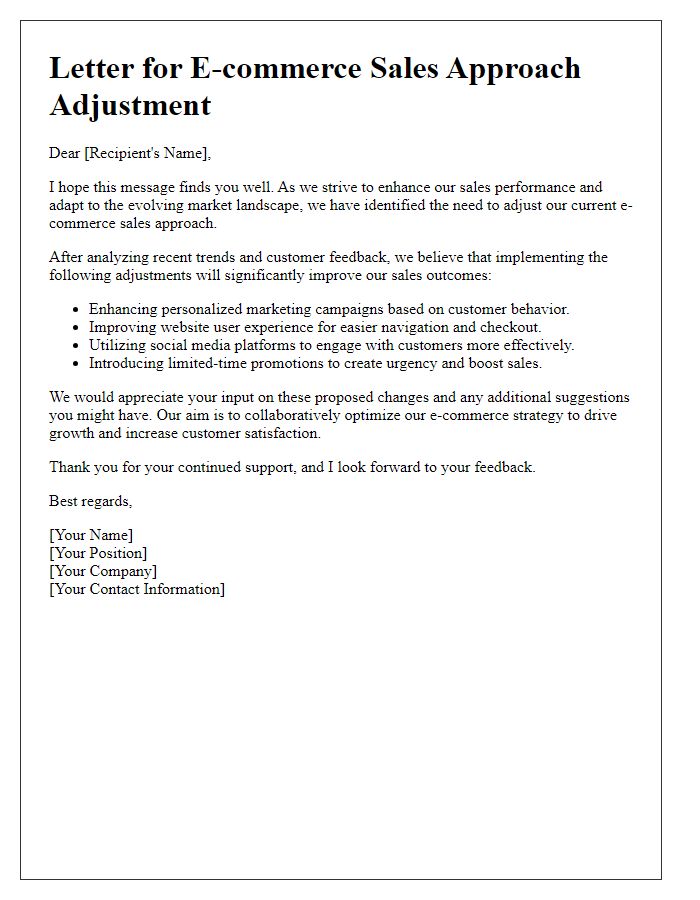Hey there! In the fast-paced world of e-commerce, it's essential to stay ahead of the game with an effective marketing strategy. We've been closely analyzing recent trends and consumer behaviors to ensure that our approach is not only relevant but also impactful. As we continue to refine our tactics and embrace innovation, we're excited to share the latest updates and insights with you. Join us as we dive deeper into these strategies and discover how they can benefit your business!

Personalization Tactics
Personalization tactics in e-commerce marketing involve tailoring experiences to individual customers, significantly enhancing engagement and conversion rates. Advanced algorithms analyze consumer behavior and preferences on platforms like Shopify or WooCommerce. These insights enable personalized recommendations, such as suggesting relevant products based on previous purchases, search history, and browsing patterns. Email marketing campaigns, utilizing tools like Mailchimp or Klaviyo, can leverage customer data for targeted messages, including birthday discounts or abandoned cart reminders. Additionally, dynamic website content can adapt to user profiles, showcasing unique offers or localized promotions. Implementing these strategies can lead to increased customer loyalty and higher average order values, ultimately driving sales growth.
Data-Driven Insights
E-commerce marketing strategy updates can greatly benefit from data-driven insights, which include analytics from platforms like Google Analytics or Shopify. Conversion rates, for instance, reveal customer behavior, showing that less than 3% of website visitors typically make a purchase. Customer demographics, such as age and location, provide insights into buying preferences, helping to tailor marketing campaigns more effectively. Seasonal trends, such as increased online shopping during Black Friday or Cyber Monday, can significantly influence inventory management and promotional strategies. Additionally, tracking customer engagement metrics, including average session duration (averaging around 2 to 3 minutes), can highlight areas for improvement in website design and user experience. Understanding customer feedback through reviews and surveys can also guide future product offerings and enhance overall satisfaction.
Omnichannel Integration
Omnichannel integration refers to the seamless connection of multiple sales channels, such as e-commerce websites, mobile apps, and brick-and-mortar storefronts, aimed at enhancing the customer shopping experience. This strategy allows consumers to engage with a brand through various touchpoints, facilitated by technologies like CRM (Customer Relationship Management) systems and marketing automation tools. In 2023, the global omnichannel retail market is projected to reach $8.55 trillion, highlighting the growing importance of a cohesive shopping journey. Companies are leveraging data analytics to track consumer behavior across channels, ensuring personalized marketing efforts that resonate with individual preferences. Effective omnichannel integration fosters customer loyalty and increases sales conversions by providing a consistent brand experience, whether shoppers are making purchases in-person, on a mobile device, or through social media platforms. Additionally, successful implementation requires investments in logistics, inventory management systems, and responsive design for all digital interfaces, ensuring that brand interactions are efficient and enjoyable.
Customer Retention Strategies
Customer retention strategies in e-commerce focus on maintaining long-term relationships with buyers, increasing repeat purchases. Techniques like personalized email marketing (utilizing customer purchase history and preferences) enhance engagement. Loyalty programs, offering points or discounts for repeat purchases, incentivize consumers to return, driving revenue growth. Subscription services provide convenience, ensuring regular purchases while promoting brand loyalty. High-quality customer service, including live chat and easy returns, fosters trust and satisfaction, significantly reducing churn rates. Implementing feedback loops through surveys can identify pain points and areas for improvement, directly addressing customer needs. Regular performance analysis, employing metrics such as customer lifetime value (CLV) and churn rate, helps refine strategies effectively.
SEO Optimization Techniques
SEO optimization techniques are essential for enhancing the visibility of e-commerce websites, with strategies such as keyword research, on-page optimization, and link building. Keyword research involves identifying popular search terms, with tools like Google Keyword Planner revealing trends for specific products, such as "wireless headphones," which garnered over 2 million monthly searches in 2023. On-page optimization includes improving product descriptions, meta tags, and image alt texts to ensure search engines can accurately index content, which is vital for organic traffic. Strategic link building focuses on acquiring backlinks from authoritative sites, enhancing domain authority, and improving search rankings. Furthermore, local SEO tactics, such as optimizing Google My Business listings, play a crucial role in attracting nearby customers, especially for brick-and-mortar e-commerce ventures in specific regions, like New York City. Regular updates, such as blog content highlighting buyer guides or product comparisons, keep audiences engaged and informed, driving sustained organic traffic growth.













Comments